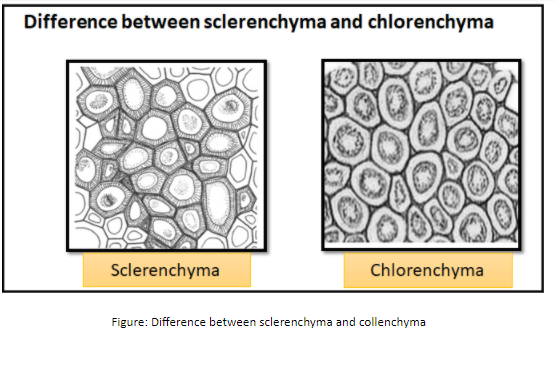
Differentiate between collenchyma and sclerenchyma.
Answer
517.8k+ views
Hint: They are ground tissues of plants that are not part of dermal tissues or vascular tissues. They are soft parts of the plants, such as cortex, pith, pericycle, etc.
Complete answer:
Ground tissues arise from the ground meristem. based on nature, morphology, and composition of the cell walls it is divided into three types, i.e. parenchyma, collenchyma, sclerenchyma. Collenchyma cells are commonly found adjacent to outer growing tissues such as the vascular cambium and help in structural support and integrity. Unlike the collenchyma, Sclerenchyma is composed of dead cells with very thick cell walls and supports tissue in plants.
Difference between collenchyma and sclerenchyma:

Note: -Lignin is an organic polymer that makes important structural parts in the support tissues of vascular plants and some algae.
-Sclereids are a reduced form of sclerenchyma cells that have highly thickened and lignified cell walls. It forms small bundles of strong layers of tissue in most plants.
Complete answer:
Ground tissues arise from the ground meristem. based on nature, morphology, and composition of the cell walls it is divided into three types, i.e. parenchyma, collenchyma, sclerenchyma. Collenchyma cells are commonly found adjacent to outer growing tissues such as the vascular cambium and help in structural support and integrity. Unlike the collenchyma, Sclerenchyma is composed of dead cells with very thick cell walls and supports tissue in plants.
Difference between collenchyma and sclerenchyma:
| Collenchyma | Sclerenchyma |
| Collenchyma cells are generally living cells with a thick primary cell wall. | They are dead cells with extremely thick secondary cell walls. |
| These cells are filled up with protoplasm. | These cells are empty. |
| The cell walls consist of cellulose and pectin. | The cell walls are made up of cellulose, hemicellulose, and lignin. |
| It has simple and straight pits. | It has simple and oblique pits. It may be branched. |
| Collenchyma allows plant organs to stretch and elongate. | Sclerenchyma is supporting cells and ceases elongation in plant tissues |
| These cells provide structural support to growing shoots and leaves. | They provide strength and support to the elements in plant parts that have ceased elongation |
| The lumen or cell cavity of collenchyma is usually narrow. | The lumen or cell cavity of sclerenchyma is wide. |

Note: -Lignin is an organic polymer that makes important structural parts in the support tissues of vascular plants and some algae.
-Sclereids are a reduced form of sclerenchyma cells that have highly thickened and lignified cell walls. It forms small bundles of strong layers of tissue in most plants.
Recently Updated Pages
Master Class 11 Economics: Engaging Questions & Answers for Success

Master Class 11 English: Engaging Questions & Answers for Success

Master Class 11 Social Science: Engaging Questions & Answers for Success

Master Class 11 Biology: Engaging Questions & Answers for Success

Class 11 Question and Answer - Your Ultimate Solutions Guide

Master Class 11 Business Studies: Engaging Questions & Answers for Success

Trending doubts
10 examples of friction in our daily life

One Metric ton is equal to kg A 10000 B 1000 C 100 class 11 physics CBSE

Difference Between Prokaryotic Cells and Eukaryotic Cells

1 Quintal is equal to a 110 kg b 10 kg c 100kg d 1000 class 11 physics CBSE

Explain zero factorial class 11 maths CBSE

What is a periderm How does periderm formation take class 11 biology CBSE




